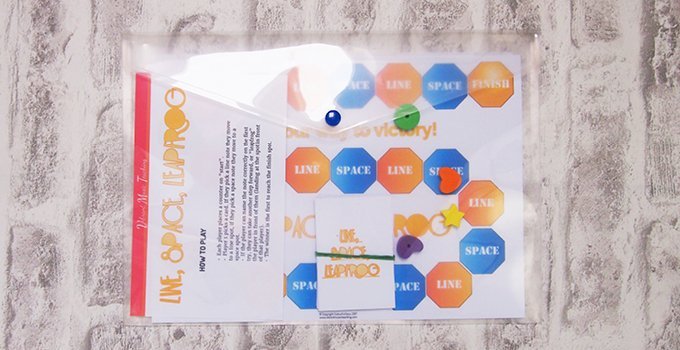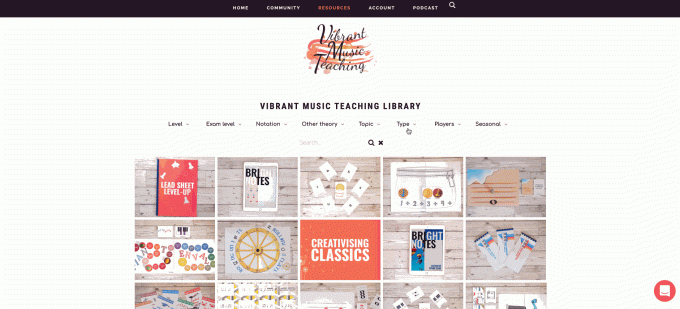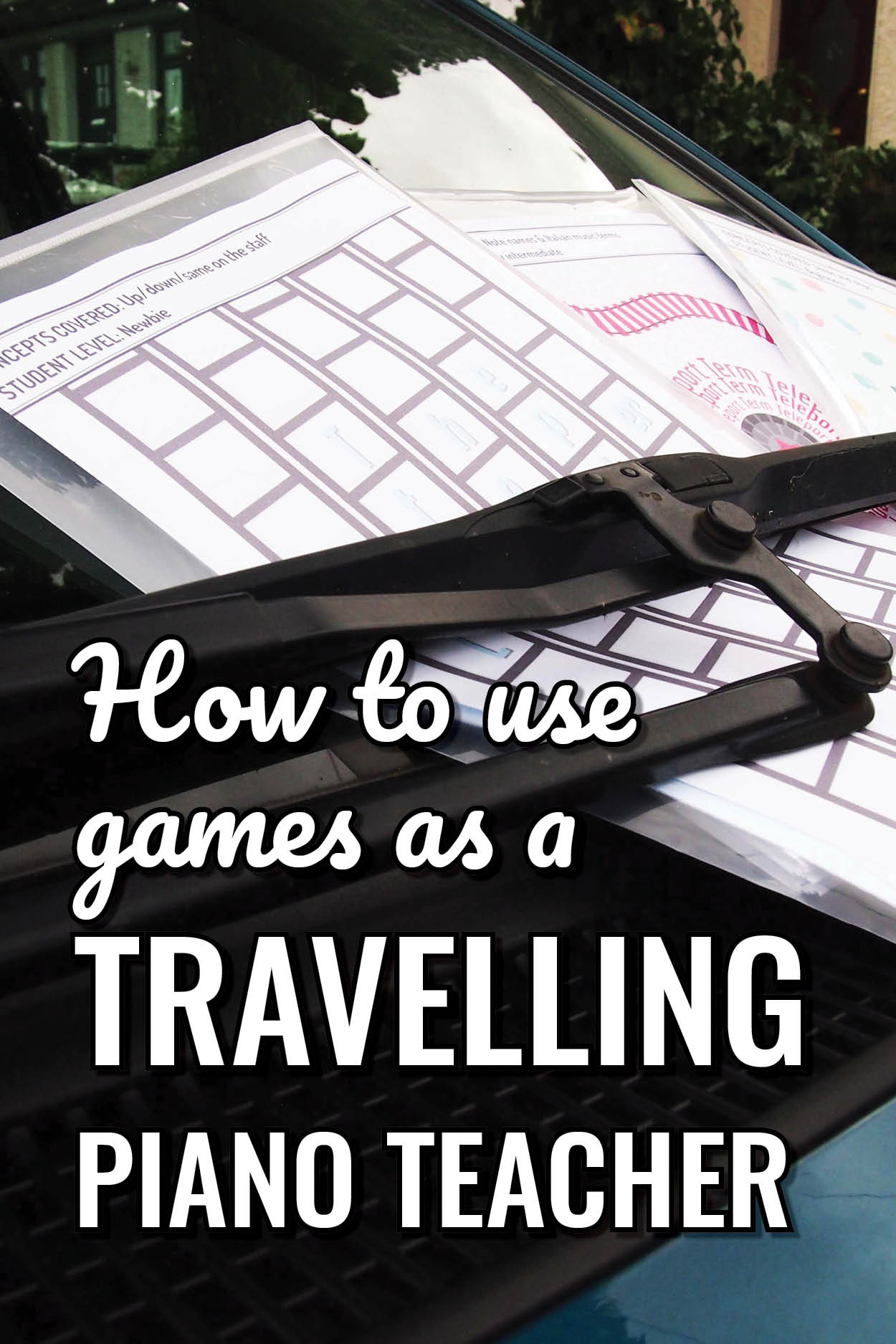Using games as a travelling piano teacher can be a little cumbersome. You can’t exactly have a whole library of games and off-the-bench activities at your disposal on the road…
Can travelling piano teachers even use games at all?

I used to travel to students’ houses to teach for many years so trust me, I get it.
Teachers with a studio space have a choice of whether they plan for the day or not (although I do think all piano teachers should do some type of lesson planning) but for travelling piano teachers, it’s a necessity.
When you’re teaching on the road, if it’s not in your bag, it’s not happening.
Games can absolutely work for at-home piano teachers. In fact, when I first started using games to teach I was teaching in students’ houses 90% of the time.
There are 3 steps to successfully using games as a travelling piano teacher:
- Making games handy and as compact as possible.
- Create a planning framework for which games you’ll use.
- Design a packing routine that fits your schedule.
Let’s get started on the first step.
Step 1: Making Piano Teaching Games Travel-Ready
I go into detail about how I store my piano teaching games here and this was born out of the need to take my games with me in my teaching bag when I went to students’ homes.
Here are the basics of how I do it:
- I print the game cover and stick it to the front of a clear plastic wallet folder (like these ones)
- If there are game cards I pop an elastic band around them and put them inside
- If there’s a game board it’s always foldable and I put that in too
- I also include the game instructions and counters/dice if they’re needed (use something flat like erasers or flat foam beads for counters to avoid adding bulk)
That’s it! Each game is now completely self-contained and ready for the road.

Step 2: Planning Games for Travelling Teachers
This is the tricky bit. This is why many travelling piano teachers despair and decide games just aren’t for them.
But here’s the magic. If you get this right, if you get this system in place, it will actually make you a better teacher.
How?
Well, I believe planning in general can make you a better teacher. And planning out which games you’re going to use can turn games from just a fun brain-break into a core part of how you teach.
It doesn’t really matter whether you do this in a notebook or a notes app on your phone. What matters is that you can think ahead and see the trajectory of each student.
Lesson Planning Using Google Sheets
My personal favourite way to do this is in Google Sheets, so that’s what I’ll explain here.
Here are the steps I show in that video:
- Set up a Google Sheets file for this semester or year.
- Create a template by putting the dates down the side and lesson categories up the top. If you just want to plan out games, simply put “Game” as the title for column 2.
- Name this sheet “Template” down the bottom.
- Duplicate the sheet and name the new one “Johnny” or whatever the first student of the week is.
- Continue duplicating and renaming until you have a sheet for each student, in the order of your timetable/schedule.
- Fill in the blanks! What do you want them to learn about each week? Write in a game that can work on that concept!
It may be helpful to correlate this with where they’re likely to be up to in their method books or theory book each week. Add columns to suit how you think about your students’ progress and any other info that will help you to plan effectively.
Finding the Right Games for Each Situation
Of course, it’s not always easy to find the right game for the right situation. That’s exactly why I created the Vibrant Music Teaching membership.
The games library is one of many fantastic features of the membership and it allows you to search by level, concept, type…you name it! It makes planning games as a travelling piano teacher (or a studio piano teacher for that matter!) so much easier.

If you’re not a member you can find out more about membership here.
Step 3: Packing Games for At-Home Piano Lessons
Now that the games are organised and you know which ones you want, it’s just a matter of opening up your plan and grabbing the right ones each day.

Pop the games in your teaching bag and you’re good to go!
Bonus Step: The Back-Up Plan
One bright spot to come out of the pandemic is that lots of our Vibrant Music Teaching games are now available in digital-friendly formats. If you already take your iPad, tablet or computer with you to student’s homes, you should definitely download some to have as a back-up plan!
Click here to learn how the slides versions of games work if you haven’t used them before.

If you’re not a member of Vibrant Music Teaching yet, you can find out more here.
Are you a travelling piano teacher?
Do you use games in your lessons? Have you found it hard to plan which ones you need each day? Have you given up?!
Tell me about your experiences with using games as a travelling piano teacher in the comments. 🙂

I do take games to one student I travel to because he is attentive and I can get it done in 1/2 hour. The other one I travel to, manages to waste the lesson time because he can’t remember anything about the pieces we are working on and he moves very slowly. There is tons of saying the same thing week after week. He rarely gets a game except in the summer time. I have a travel bag and I keep the games in there so I am ready to go with them. At home, when teaching, I can grab the games out of the same bag. I like the spreadsheet and had never thought of it.
Thanks for sharing your experience Linda! I think even (and especially!) the slowest moving, apparently inattentive students can benefit from games. Maybe try a game at the start of the next lesson on a concept he is struggling with (note names, intervals, etc.) and just test it out. There’s a chance you actually get more done during that lesson even though you took time to play a game first! 😀
This is timely as I plan for 3 studios. I am using different procedures to see what works. I plan ‘concept specific’ per student as needed but also have a studio wide theme for games (in my personal year long plan) which can be concept or holiday/season related. My travel bag is always bulging
My travel bag was always pretty heavy, good workout carrying that thing around! Hope this post helps you with your planning Teresa. 🙂
I’m trying the Google Sheets! But when I went to duplicate the dates in the first column, Google changed the year, and the dates didn’t look right! I did it just like you did in the video, so I’m not sure where I went wrong?
Did you do 2 dates? It has to be a pattern so that the software can follow it. Double-check your first 2 dates are exactly a week apart and try again.
I travel to teach at a private church run school. My ” studio” is the church sanctuary. This means that I can not store anything there and I need to step up my space every time I come. The schedule limits me to back to back 30 minute lessons. Planning ahead is the only way I can make this workable. Since I have plenty of space, I can set up games in different areas to get me through the morning. On my lunch break I clean up and set up for the afternoon. At the end of the school day I have some time to set a for after school lessons.
My teaching bag is a rolling craft caddy suitcase made for scrap booking. The main space has adjustable dividers. This works great for rhythm instruments, metronome, floor staff, a small Lego set, and other larger objects. The outside sides have expandable pockets. One is open and holds many books. The others have many see through pockets to hold little things. My pedal extender sits nicely on top and I can haul everything in one trip.
My only problem is the piano does not have an adjustable bench. I have figured out how to carry that with me.
That sounds tricky but seems like you’re making it work!